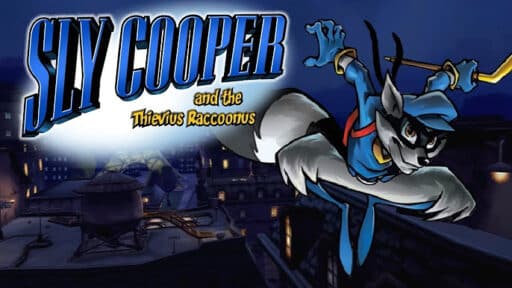
Sly Cooper and the Thievius Raccoonus
When it comes to the creation of flagship Sony franchises, Sucker Punch has always played third fiddle to Naughty Dog and Insomniac. After playing Sly Cooper, I wouldn’t say that reputation is undeserved. Whereas Ratchet & Clank combined a 3D platformer with a third-person shooter, Sly mixes a 3D platformer with stealth gameplay to considerably less potent results. There are a couple of reasons for this, but the most blatant is that the stealth gameplay just doesn’t engage correctly. There’s almost always one intended way around a given obstacle, and when more organic opportunities arise, they usually just devolve into sneaking behind guards and knocking them out. The result isn’t so much a stealth platformer as a platformer with oddly inconvenient enemies.
The platforming itself is inconsistent but ultimately enjoyable. The basic controls are somewhat rickety, but the more advanced maneuvers are all mapped to a single context-sensitive button, allowing for fluid, Assassin’s Creed-style parkour half a decade before Assassin’s Creed existed. One particular stroke of brilliance was tying many of these techniques to the protagonist’s hook-cane, which he uses to grab objects from afar. This allows for extremely forgiving hit detection without feeling like the game is just holding your hand the entire time. The main gameplay is also supplemented by a number of minigames, as is seemingly tradition for Sony mascot titles. While they all suffer from weightless and uncooperative controls, they’re entertaining enough to occupy a sweet spot where they don’t feel token but also don’t overstay their welcome.
The most disappointing thing about Sly Cooper is that all of the pieces of a fantastic game are here; they’re just put together wrong. New abilities are unlocked via collect-a-thon side tasks, giving players reason to achieve them beyond 100% completion, but because of the gameplay’s rigid structure, they range from completely useless to trivializing entire levels. In-game, the animation is smooth and expressive, but it’s often unfinished in cutscenes. The music would be quite pleasant if it wasn’t unbearably repetitive. There’s even a more significant attempt at narrative than most platformers, but frankly it’s a pretty forced attempt. I think the only thing I consistently appreciated here was the level design, which is unusually ambitious and kinetic.